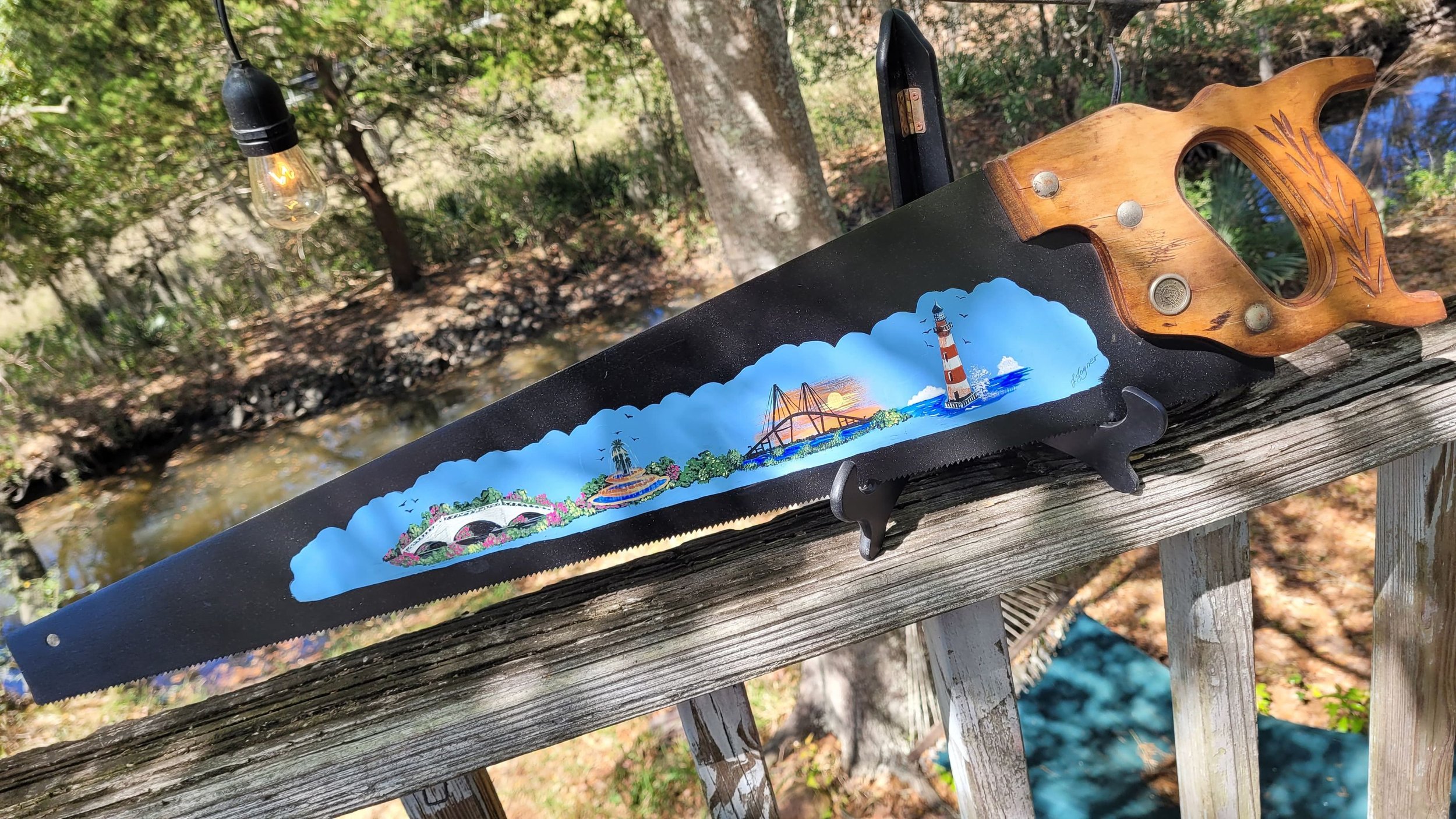
Gallery Artwork and Such
One of a kind pieces of artwork created on single antique or historic canvases connected to Charleston, South Carolina and the surrounding areas.
Iconic Charleston 26" Vintage Handsaw
Iconic Charleston 26" Vintage Handsaw
- What has teeth, a bite, but can’t hurt you? This glorious piece of art.
- Hand-painted Vintage Fine Toothed, ‘Wheat” Carved Handle Handsaw Locally Used and Sourced in South Carolina.
- This is a one-of-a-kind piece decorated with acrylic paints.
- DECORATIVE USE ONLY
A Brief History of Rainbow Row
If you were to ask a native Charlestonian about Rainbow Row (i.e., What is it?, Where is it ?, Etc.) your answers would be pretty much the same from them all. We all know something about the pretty pastel houses lined up along East Bay Street, south of Broad Street. You might get some personal answers like – “they have been there as long as I remember” or “that their colors never change.” These bits and pieces are true as far as they go, but you would be missing what Paul Harvey would call – “the rest of the story.”
The houses of Rainbow Row were built between 1748 and 1845 along the riverfront as commercial units with living space on the second and third floors. Over the course of their existence, these houses from 79 to 107 East Bay Street have seen prosperity and recession; wind, rain and storm; and most notably massive damage from hurricanes, fires and earthquakes. Through all of these misfortunes, the “Row” has stood due in part to the resilience of their individual owners, but mostly due to the overall sense of community that pressed for their rebuilding, repair, or renovation.
These homes have been the property of many Charleston notables and their families as well as those who came to visit and never left. This collage of personalities saw the “Row” through the early years of new industry and growth as well as the years of war and sorrow. They also brought the row from economic success to the drab darkness of decay. Compounded by Charleston’s famous fires and earthquakes, Rainbow Row fell to its lowest point in the early 1900s when it was seen as the slum of the “east-side.”
Not wanting visitors or residents to take this visage as a lasting impression of Charleston, several of Charleston’s ablest citizens took it upon themselves to change the “Rows’” image. Starting with Susan Pringle Frost’s purchase of several of the houses beginning in 1920 and subsequent purchases by Lionel and Dorothy Legge in 1931 and John McGowan in 1938, the properties from 79 to 107 East Bay were restored, rebuilt or renovated to the “glory” that is theirs today. When Justice and Mrs. Legge purchased 99/101 East Bay for restoration, Mrs. Legge decided on the Caribbean Pink exterior to help cool the house during the Charleston summers, not necessarily so people could tell which one was theirs. The other owner followed suit with pastel colors of their own choosing thus giving us what today is referred to fondly as Charleston’s Rainbow Row.
The effect of their transformation resulted in the Charleston Society for Preservation of Old Homes, later to be known as Charleston’s Preservation Society. Along with the influence of the Charleston Historical Society, other parts of Charleston became targets for renewal and restoration followed by adaptation of local legal codes. These codes guided not only the restoration of Charleston’s neighborhoods, but also the building of new properties so that they would not detract from Charleston’s unique historical look and feel.
These thirteen homes on East Bay Street have stood the test of time to become the longest row of Georgian style architecture in the country. “Rainbow Row” is a beacon of its citizens’ strength when faced with adversity and as part of Charleston is reflective of the city's grace and style.
~ David Joyner

















